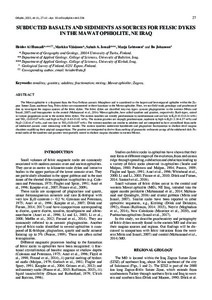SUBDUCTED BASALTS AND SEDIMENTS AS SOURCES FOR FELSIC DYKES IN THE MAWAT OPHIOLITE, NE IRAQ
Al Humadi Heider; Väisänen Markku; Ismail Sabah A.; Lehtonen Marja; Johanson Bo
https://urn.fi/URN:NBN:fi-fe2021042822492
Tiivistelmä
The Mawat ophiolite is a fragment from the Neo-Tethyan oceanic lithosphere and is considered as the largest and best-exposed ophiolite within the Zagros Suture Zone, northeast Iraq. Felsic dykes are encountered in three locations in the Mawat ophiolite. Here, we use field work, petrology and geochemical data to investigate the magma sources of the felsic dykes. The felsic dykes are classified into two types: oceanic plagiogranites in the western (Mirza and Ismail, 2007) and leucogranites in the central (Mohammad et al., 2014) Mawat ophiolite, here called tonalites and granites, respectively. Both types, mixed in various proportions occur in the eastern felsic dykes. The eastern tonalites are weakly peraluminous to metaluminous and are low in K2O (0.13-0.24 wt%) and TiO2 (0.01-0.07 wt%) and high in Na2O (6.63-11.02 wt%). The eastern granites are strongly peraluminous, moderate to high in K2O (1.16-6.57 wt%) and Na2O (2.83-6.47 wt%), and very low in TiO2 (0.03-0.07 wt%). The western tonalites are similar to adakites and are interpreted to have crystallized from melts of subducted oceanic crust interacting with the mantle. The eastern tonalites underwent hornblende and plagioclase fractionation in shallow-level magma chambers modifying their original compositions. The granites are interpreted to derive from melting of psammitic sediments on top of the subducted slab. Parental melts of the tonalities and granites were partially mixed in shallow magma chambers in eastern Mawat.
Kokoelmat
- Rinnakkaistallenteet [27094]
